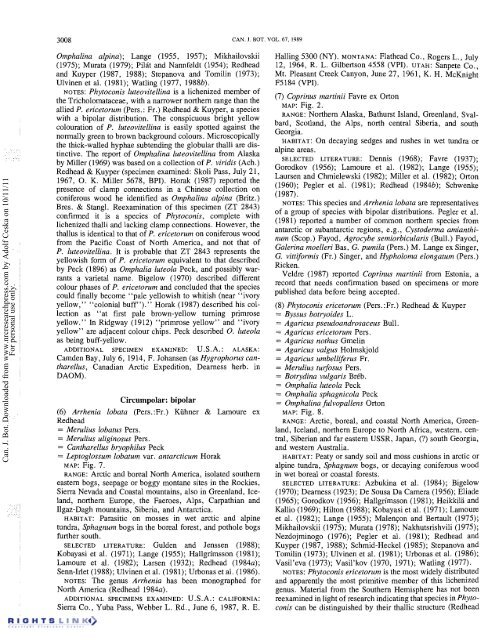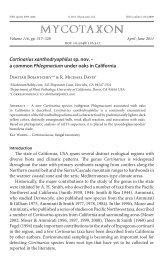Redhead Fungal Biogeography.pdf - Mushroom Hobby
Redhead Fungal Biogeography.pdf - Mushroom Hobby
Redhead Fungal Biogeography.pdf - Mushroom Hobby
You also want an ePaper? Increase the reach of your titles
YUMPU automatically turns print PDFs into web optimized ePapers that Google loves.
Can. J. Bot. Downloaded from www.nrcresearchpress.com by Adolf Ceska on 10/11/11<br />
For personal use only.<br />
3008<br />
Omphalina alpina); Lange (1955, 1957); Mikhailovskii<br />
(1975); Murata (1979); Pilfit and Nannfeldt (1954); <strong>Redhead</strong><br />
and Kuyper (1987, 1988); Stepanova and Tomilin (1973);<br />
Ulvinen et al. (1981); Watling (1977, 1988b).<br />
NOTES: Phytoconis luteovitellina is a lichenized member of<br />
the Tricholomataceae, with a narrower northern range than the<br />
allied P. ericetorum (Pers.: Fr.) <strong>Redhead</strong> & Kuyper, a species<br />
with a bipolar distribution. The conspicuous bright yellow<br />
colouration of P. luteovitellina is easily spotted against the<br />
normally green to brown background colours. Microscopically<br />
the thick-walled hyphae subtending the globular thalli are dis-<br />
tinctive. The report of Omphalina luteovitellina from Alaska<br />
by Miller (1969) was based on a collection of P. viridis (Ach.)<br />
<strong>Redhead</strong> & Kuyper (specimen examined: Skoli Pass, July 21,<br />
1967, 0. K. Miller 5678, BPI). Horak (1987) reported the<br />
presence of clamp connections in a Chinese collection on<br />
coniferous wood he identified as Omphalina alpina (Britz.)<br />
Bres. & Stangl. Reexamination of this specimen (ZT 2843)<br />
confirmed it is a species of Phytoconis, complete with<br />
lichenized thalli and lacking clamp connections. However, the<br />
thallus is identical to that of P. ericetorum on coniferous wood<br />
from the Pacific Coast of North America, and not that of<br />
P. luteovitellina. It is probable that ZT 2843 represents the<br />
yellowish form of P. ericetorum equivalent to that described<br />
by Peck (1896) as Omphalia luteola Peck, and possibly war-<br />
rants a varietal name. Bigelow (1970) described different<br />
colour phases of P. ericetorum and concluded that the species<br />
could finally become "pale yellowish to whitish (near "ivory<br />
yellow, " "colonial buff"). " Horak (1987) described his col-<br />
lection as "at first pale brown-yellow turning primrose<br />
yellow. " In Ridgway (1912) "primrose yellow" and "ivory<br />
yellow" are adjacent colour chips. Peck described 0. luteola<br />
as being buff-yellow.<br />
ADDITIONAL SPECIMEN EXAMINED: U.S.A.: ALASKA:<br />
Camden Bay, July 6, 1914, F. Johansen (as Hygrophorus can-<br />
tharellus, Canadian Arctic Expedition, Dearness herb. in<br />
DAOM) .<br />
Circumpolar: bipolar<br />
(6) Arrhenia lobata (Pers.:Fr.) Kiihner & Lamoure ex<br />
<strong>Redhead</strong><br />
= Merulius lobatus Pers.<br />
= Merulius uliginosus Pers.<br />
= Cantharellus bryophilus Peck<br />
= Leptoglossum lobatum var. antarcticum Horak<br />
MAP: Fig. 7.<br />
RANGE: Arctic and boreal North America, isolated southern<br />
eastern bogs, seepage or boggy montane sites in the Rockies,<br />
Sierra Nevada and Coastal mountains, also in Greenland, Iceland,<br />
northern Europe, the Faeroes, Alps, Carpathian and<br />
Ilgaz-Dagh mountains, Siberia, and Antarctica.<br />
HABITAT: Parasitic on mosses in wet arctic and alpine<br />
tundra, Sphagnum bogs in the boreal forest, and pothole bogs<br />
further south.<br />
SELECTED LITERATURE: Gulden and Jenssen (1988);<br />
Kobayasi et al. (197 1); Lange (1955); Hallgnmsson (198 1);<br />
Lamoure et al. (1982); Larsen (1932); <strong>Redhead</strong> (1984a);<br />
Senn-Irlet (1988); Ulvinen et al. (1981); Urbonas et al. (1986).<br />
NOTES: The genus Arrhenia has been monographed for<br />
North America (<strong>Redhead</strong> 1984a).<br />
ADDITIONAL SPECIMENS EXAMINED: U.S. A. : CALIFORNIA:<br />
Sierra Co., Yuba Pass, Webber L. Rd., June 6, 1987, R. E.<br />
CAN. J. BOT. VOL. 67. 1989<br />
Halling 5300 (NY). MONTANA: Flathead Co., Rogers L., July<br />
12, 1964, R. L. Gilbertson 4558 (VPI). UTAH: Sanpete Co.,<br />
Mt. Pleasant Creek Canyon, June 27, 1961, K. H. McKnight<br />
F5 184 (VPI) .<br />
(7) Coprinus martinii Favre ex Orton<br />
MAP: Fig. 2.<br />
RANGE: Northern Alaska, Bathurst Island, Greenland, Svalbard,<br />
Scotland, the Alps, north central Siberia, and south<br />
Georgia.<br />
HABITAT: On decaying sedges and rushes in wet tundra or<br />
alpine areas.<br />
SELECTED LITERATURE: Dennis (1968); Favre (1937);<br />
Gorodkov (1956); Lamoure et al. (1982); Lange (1955);<br />
Laursen and Chmielewski (1982); Miller et al. (1982); Orton<br />
(1960); Pegler et al. (1981); <strong>Redhead</strong> (1984b); Schwenke<br />
(1 987).<br />
NOTES: This species and Arrhenia lobata are representatives<br />
of a group of species with bipolar distributions. Pegler et al.<br />
(1981) reported a number of common northern species from<br />
antarctic or subantarctic regions, e.g., Cystoderma amiantlzinum<br />
(Scop.) Fayod, Agrocybe semiorbicularis (Bull.) Fayod,<br />
Galerina moelleri Bas, G. pumila (Pers.) M. Lange ex Singer,<br />
G. vittiformis (Fr.) Singer, and Hypholoma elongatum (Pers.)<br />
Ricken.<br />
Veldre (1987) reported Coprinus martinii from Estonia, a<br />
record that needs confirmation based on specimens or more<br />
published data before being accepted.<br />
(8) Phytoconis ericetorum (Pers.:Fr.) <strong>Redhead</strong> & Kuyper<br />
= Byssus botryoides L.<br />
= Agaricus pseudoandrosaceus Bull.<br />
= Agaricus ericetorum Pers .<br />
= Agaricus nothus Gmelin<br />
= Agaricus valgus Holmskjold<br />
= Agaricus umbelliferus Fr.<br />
= Merulius tu$osus Pers.<br />
= Botrydina vulgaris Brkb.<br />
= Omphalia luteola Peck<br />
= Omphalia sphagnicola Peck<br />
= Omphalina fulvopallens Orton<br />
MAP: Fig. 8.<br />
RANGE: Arctic, boreal, and coastal North America, Greenland,<br />
Iceland, northern Europe to North Africa, western, central,<br />
Siberian and far eastern USSR, Japan, (?) south Georgia,<br />
and western Australia.<br />
HABITAT: Peaty or sandy soil and moss cushions in arctic or<br />
alpine tundra, Sphagnum bogs, or decaying coniferous wood<br />
in wet boreal or coastal forests.<br />
SELECTED LITERATURE: Azbukina et al. (1984); Bigelow<br />
(1970); Dearness (1923); De Sousa Da Camera (1956); Eliade<br />
(1965); Gorodkov (1956); Hallgnmsson (1981); Heikkila and<br />
Kallio (1969); Hilton (1988); Kobayasi et al. (1971); Lamoure<br />
et al. (1982); Lange (1955); Malen~on and Bertault (1975);<br />
Mikhailovskii (1975); Murata (1978); Nakhutsrishvili (1975);<br />
Nezdojminogo (1976); Pegler et al. (1981); <strong>Redhead</strong> and<br />
Kuyper (1987, 1988); Schmid-Heckel (1985); Stepanova and<br />
Tomilin (1973); Ulvinen et al. (1981); Urbonas et al. (1986);<br />
Vasil'eva (1973); Vasil'kov (1970, 1971); Watling (1977).<br />
NOTES: Phytoconis ericetorum is the most widely distributed<br />
and apparently the most primitive member of this lichenized<br />
genus. Material from the Southern Hemisphere has not been<br />
reexamined in light of research indicating that species in Phytoconis<br />
can be distinguished by their thallic structure (<strong>Redhead</strong>



